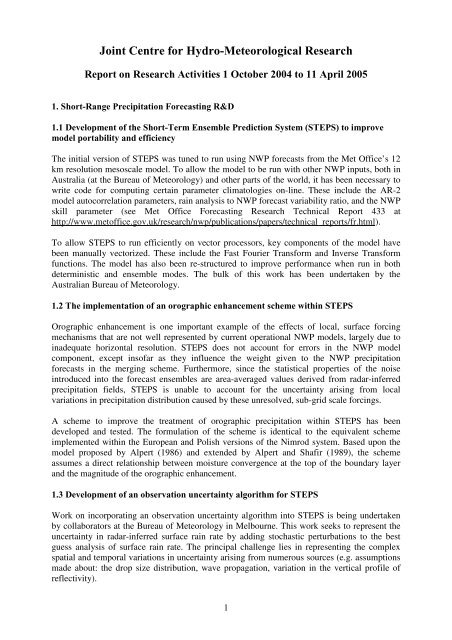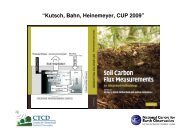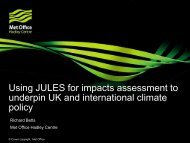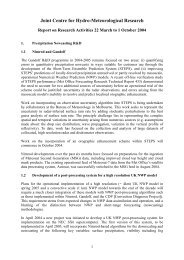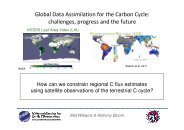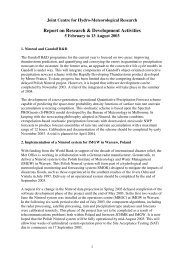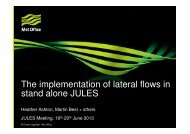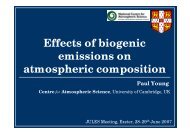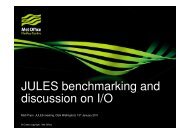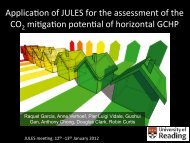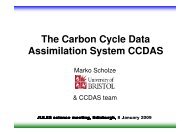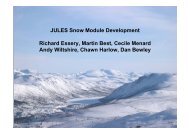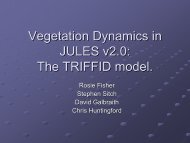Report - Joint Centre for Hydro-Meteorological Research
Report - Joint Centre for Hydro-Meteorological Research
Report - Joint Centre for Hydro-Meteorological Research
You also want an ePaper? Increase the reach of your titles
YUMPU automatically turns print PDFs into web optimized ePapers that Google loves.
<strong>Joint</strong> <strong>Centre</strong> <strong>for</strong> <strong>Hydro</strong>-<strong>Meteorological</strong> <strong>Research</strong><strong>Report</strong> on <strong>Research</strong> Activities 1 October 2004 to 11 April 20051. Short-Range Precipitation Forecasting R&D1.1 Development of the Short-Term Ensemble Prediction System (STEPS) to improvemodel portability and efficiencyThe initial version of STEPS was tuned to run using NWP <strong>for</strong>ecasts from the Met Office’s 12km resolution mesoscale model. To allow the model to be run with other NWP inputs, both inAustralia (at the Bureau of Meteorology) and other parts of the world, it has been necessary towrite code <strong>for</strong> computing certain parameter climatologies on-line. These include the AR-2model autocorrelation parameters, rain analysis to NWP <strong>for</strong>ecast variability ratio, and the NWPskill parameter (see Met Office Forecasting <strong>Research</strong> Technical <strong>Report</strong> 433 athttp://www.metoffice.gov.uk/research/nwp/publications/papers/technical_reports/fr.html).To allow STEPS to run efficiently on vector processors, key components of the model havebeen manually vectorized. These include the Fast Fourier Trans<strong>for</strong>m and Inverse Trans<strong>for</strong>mfunctions. The model has also been re-structured to improve per<strong>for</strong>mance when run in bothdeterministic and ensemble modes. The bulk of this work has been undertaken by theAustralian Bureau of Meteorology.1.2 The implementation of an orographic enhancement scheme within STEPSOrographic enhancement is one important example of the effects of local, surface <strong>for</strong>cingmechanisms that are not well represented by current operational NWP models, largely due toinadequate horizontal resolution. STEPS does not account <strong>for</strong> errors in the NWP modelcomponent, except insofar as they influence the weight given to the NWP precipitation<strong>for</strong>ecasts in the merging scheme. Furthermore, since the statistical properties of the noiseintroduced into the <strong>for</strong>ecast ensembles are area-averaged values derived from radar-inferredprecipitation fields, STEPS is unable to account <strong>for</strong> the uncertainty arising from localvariations in precipitation distribution caused by these unresolved, sub-grid scale <strong>for</strong>cings.A scheme to improve the treatment of orographic precipitation within STEPS has beendeveloped and tested. The <strong>for</strong>mulation of the scheme is identical to the equivalent schemeimplemented within the European and Polish versions of the Nimrod system. Based upon themodel proposed by Alpert (1986) and extended by Alpert and Shafir (1989), the schemeassumes a direct relationship between moisture convergence at the top of the boundary layerand the magnitude of the orographic enhancement.1.3 Development of an observation uncertainty algorithm <strong>for</strong> STEPSWork on incorporating an observation uncertainty algorithm into STEPS is being undertakenby collaborators at the Bureau of Meteorology in Melbourne. This work seeks to represent theuncertainty in radar-inferred surface rain rate by adding stochastic perturbations to the bestguess analysis of surface rain rate. The principal challenge lies in representing the complexspatial and temporal variations in uncertainty arising from numerous sources (e.g. assumptionsmade about: the drop size distribution, wave propagation, variation in the vertical profile ofreflectivity).1
1.4 Development of the European Nimrod nowcasting systemWork on the replacement of the Global Model feed into European Nimrod with one from theNorth Atlantic and European (NAE) model has been delayed due to issues with theper<strong>for</strong>mance of the NAE model. Work to migrate several nowcasting algorithms, including theMOSES-PDM soil moisture–runoff models, from the UK version of Nimrod to EuropeanNimrod prior to retirement of the <strong>for</strong>mer, will commence later this year.2. Development of a post-processing system <strong>for</strong> high resolution UK NWP modelsAn initial version of a post-processing system <strong>for</strong> the 4km resolution UK NWP model has beendeveloped and tested, and is now running under the parallel suite on the Met Office’ssupercomputer – the NEC SX8. The system incorporates algorithms <strong>for</strong> the interpolation ofUK NWP model fields to a 2 km resolution grid and the nowcasting of precipitation type,visibility, wind and pressure. Algorithms <strong>for</strong> the prediction of precipitation and cloud, and thegeneration of site specific <strong>for</strong>ecasts will be added in May 2005, following completion of workon the deterministic version of STEPS.A web-based, interactive display system and verification software have been implemented onthe Nimrod hardware in lieu of the introduction of a new, centralised data repository, planned<strong>for</strong> later this year.3. Development of a storm-scale NWP model <strong>for</strong> quantitative precipitation <strong>for</strong>ecastingA scientist at the <strong>Joint</strong> <strong>Centre</strong> <strong>for</strong> Mesoscale Meteorology (JCMM), at Reading, who spent oneday a week at the JCHMR, has completed a 2-year project to assess the hydrologicalper<strong>for</strong>mance of the Met Office NWP model when experimentally run with grid-lengths of 1-4km. The work was jointly funded by the Met Office and Defra.The final scientific report (Forecasting <strong>Research</strong> Technical <strong>Report</strong> (FRTR) No.455) has beenissued (Jan 2005). The report documents the key findings from the work and tools <strong>for</strong>presenting and assessing the model output that have been developed during the course of theproject. It concluded that a storm-scale model (grid spacing ~ 1 km) is capable of producingsignificantly more realistic and spatially accurate <strong>for</strong>ecasts of convective rainfall events than ispossible with current operational systems. Evidence has come from detailed investigation ofselected cases and from per<strong>for</strong>mance statistics over a larger sample. There is now a prospect ofproducing useful <strong>for</strong>ecasts of convective storms on scales applicable <strong>for</strong> flood prediction.It is recommended that the development of a storm scale modelling system should continuetowards operational implementation and that the generation of diagnostic products <strong>for</strong> floodwarning should be an integral part of any operational system. The development of such asystem will still require further core research, particularly in the area of data assimilation (theprocess of incorporating new observational in<strong>for</strong>mation at the start of the <strong>for</strong>ecast).The final report delivered a review of the project and proposals <strong>for</strong> follow-up projects to takethe capability a stage further. Three projects were proposed.(1) An assessment of the ability of a model with a 1km grid spacing to predict extreme events(as classified by the extreme event recognition project).2
(2) Investigation of blending <strong>for</strong>ecasts from a 1km model with radar extrapolation <strong>for</strong>ecasts.(3) Investigating how outputs from a 1km NWP model can be used directly into hydrologicalmodels.4. Hyrad and RFFSCEH’s Hyrad system supports the real-time receipt, processing and display of weather radarand hydro-meteorological space-time images, especially <strong>for</strong> use in flood warning and waterresource management. A new release of Hyrad to the Environment Agency will provide thefollowing new features: (i) IT Management Tool providing statistics on successful productdelivery, (ii) Summary Rainfall Statistics (Minimum, mode, mean, median and maximum) <strong>for</strong>image-on-view and image sequences <strong>for</strong> a selected catchment or area (this will semi-automatethe construction of “radar truth” <strong>for</strong> the Rainfall Forecast Assessment PC Tool outlined in theprevious JCHMR <strong>Research</strong> Activity <strong>Report</strong>), (iii) Generation of time-series of catchmentaverage and maximum rainfall accumulations to pass to telemetry/modelling systems <strong>for</strong> alarmgeneration, (iv) Self management of user prioritization to allow a wider user pool, (v)Improved and generalized dialogs <strong>for</strong> display, (vi) Time-series charts amended to use unitsfrom data type (relevant to the new NWP rainfall/temperature and MOSES soilmoisture/snowmelt/evaporation/runoff products), and (vii) NFFS (National Flood ForecastingSystem) interface enhancements to deliver a single file per <strong>for</strong>ecast (with revised name) and tomanually populate the Met Office product reference. This release will become operational inMay 2005.CEH’s RFFS (River Flow Forecasting System) suite of modelling software encompasses bothModel Calibration tools <strong>for</strong> application off-line and Model Algorithms streamlined <strong>for</strong> realtimeuse. The Model Calibration suite include: “PDM <strong>for</strong> PCs” rainfall-runoff model, “KW <strong>for</strong>PCs” channel flow routing model and “PSM <strong>for</strong> PCs” rainfall-runoff model (encompassing theTCM and IEM models). The real-time Model Algorithms include PDM and KW, SNOW(PACK) snowmelt model, and ARMA error predictor (state correction <strong>for</strong>ms of dataassimilation are embedded within a given model type). The real-time algorithms are availablein Module Adapter <strong>for</strong>m (using an XML interface) <strong>for</strong> use with the Environment Agency’sNational Flood Forecasting System (NFFS). An Enterprise Licence <strong>for</strong> both Calibration andReal-time codes has been supplied, allowing their use in all regions of the EnvironmentAgency across England and Wales. Work is also underway in supplying the PSM in real-timeModule Adapter <strong>for</strong>m.With the above developments, the Environment Agency now has the capability to use MetOffice Nimrod products (radar, NWP and MOSES), via CEH’s Hyrad system, <strong>for</strong> use in floodwarning and water resource management throughout England and Wales.At the invitation of the French Academy of Sciences, a position paper on “Forecasting <strong>for</strong>Flood Warning” was prepared and published in Comptes Rendus Geoscience in 2005.5. Extreme Event RecognitionThis Defra R&D Project involves a Met Office lead consortium encompassing inputs fromCEH and the University of Sal<strong>for</strong>d. The overall objective is to improve the capability toprovide warnings of extreme flood events via improving rainfall <strong>for</strong>ecasts and flood <strong>for</strong>ecastingmodels/procedures (including decision-support). CEH is developing spatio-temporal rainfall3
datasets, using radar and raingauge data from historical heavy rainfall events, enhanced torepresent extreme events. These datasets are being used to evaluate and improve theper<strong>for</strong>mance of hydrological models under such extreme event conditions. They are also to beused <strong>for</strong> model destruction testing.Work has been completed on identifying Case Study events and catchments associated withextreme convective, frontal and orographic rain. Case study rainfall-runoff model applicationshave been carried out <strong>for</strong> convective storms over Boscastle (River Valency) and Blackburn(River Darwen) and <strong>for</strong> an orographic event over the rivers Kent and Upper Ure. Modelper<strong>for</strong>mance has been assessed <strong>for</strong> a lumped (PDM) and a distributed (G2G) model: noobvious breakdown in per<strong>for</strong>mance has been observed <strong>for</strong> these extreme events. Assessment athigher flows however can be constrained by the range of validity of ratings used to trans<strong>for</strong>mriver level to flow. A Rainfall Trans<strong>for</strong>mation Tool has been developed to amplify rainfallfields derived from historical data through the control of storm position, areal extent,magnitude/duration and storm movement/orientation. A new methodology <strong>for</strong> using raingaugeand/or radar data to estimate rainfall <strong>for</strong> catchment and grid-square areas has been developed.When used with the Rainfall Trans<strong>for</strong>mation Tool, it provides a methodology <strong>for</strong> constructingartificial space-time rainfall datasets <strong>for</strong> use in model response studies and <strong>for</strong> modeldestruction testing. Modelled flood response experiments are underway using these new toolsand case study datasets.6. Flood modelling <strong>for</strong> ungauged basinsThe Environment Agency are seeking improved ways of providing warnings <strong>for</strong> ungauged andlow benefit locations that presently receive only a general Flood Watch service. CEH has beencommissioned, under the EA/Defra National R&D Programme, to develop and evaluateimproved techniques <strong>for</strong> flood <strong>for</strong>ecasting at such locations with the eventual aim of theAgency offering a more targeted and technically sound flood warning service.A Guidelines <strong>Report</strong> on best practice is being developed alongside prototyping of newimproved methods. A new method of representing runoff production under the control of soiland topography, with an emphasis on lateral water transfers, is being considered. Also, avariable time-step Muskingum-type flow routing methodology with links, via the St Venantequations, to channel properties appears to have benefits <strong>for</strong> application to ungauged areas.Seeking physically-based methods of applying conceptual hydrological models to ungaugedcatchments using digital datasets on basic properties, as opposed to empirical regression oncatchment characteristics, is seen as a way <strong>for</strong>ward. A range of options <strong>for</strong> data assimilation tosupport <strong>for</strong>ecast updating, depending on the level of data availability and model structure, arebeing set down. A Technical <strong>Report</strong>, from which the Guidelines <strong>Report</strong> will be developed, is indraft <strong>for</strong>m.7. Post-event EvaluationThe extreme rainfall events of 8 th (southern England) and 16 th (Boscastle) August 2004 havebeen being studied and reports written describing the per<strong>for</strong>mance of nowcast and NWP<strong>for</strong>ecast systems during these events. The report on the Boscastle event has been issued asForecasting <strong>Research</strong> Technical <strong>Report</strong> No. 429(http://www.metoffice.gov.uk/research/nwp/publications/papers/technical_reports/fr.html).4
An extreme rainfall event produced flooding in Carlisle in early January 2005. Theper<strong>for</strong>mance of operational weather <strong>for</strong>ecasting systems has been studied and a preliminaryreport written. The per<strong>for</strong>mance of a Grid-to-Grid River Flow Model (RFM) which routesrunoff from Nimrod-MOSES-PDM was also studied. A rerun of Nimrod-MOSES-PDM-RFMwith a larger flow wave speed (which required a shorter timestep <strong>for</strong> the RFM) gave morerealistic magnitude and timing <strong>for</strong> the flood peak flow.A feature of recent post-event evaluation reports has been the plots of rainfall, runoff and riverflow with map backgrounds produced with a Geographical In<strong>for</strong>mation System (GIS) softwarepackage.8. Development and validation of soil state and surface hydrology models(i) CEH have compared observations from two LOCAR catchments (the Pang/Lambourn andthe Tern) with soil moisture from the operational Nimrod-MOSES-PDM during 2003. For thePang/Lambourn catchment, neutron probe data were available (at roughly <strong>for</strong>tnightly intervalsand down to depths in excess of 3 m) <strong>for</strong> the whole of 2003 but the profile data (hourlyintervals down to 1 m depth) were available from mid-summer to the end of the year. Thereport highlights (i) the difficulty of using site-specific soil moisture measurements <strong>for</strong>validating 5km x 5km model gridsquare means; (ii) the deficient soil moisture from the versionof Nimrod-MOSES-PDM which was operational in 2003 (note: the soil hydraulics andassociated ancillary fields were changed to the van Genuchten <strong>for</strong>mulation in May 2004); (iii)some problems with the radar rainfall analyses in late April to mid June 2003 and (iv) thespecial nature of water movement through chalk which isn’t represented well in MOSES.(ii) The ELDAS project (European Land Data Assimilation System to predict Floods andDroughts) is supported by the European Union in the context of the Fifth FrameworkProgramme. Scientists from the JCHMR have been involved in a case study to compare theELDAS soil hydrology to the operational data available <strong>for</strong> the Autumn 2000 floods affectingSouth East England. Soil moisture data, generated by the Tessel land-surface scheme, wereused to replace soil moisture estimates within PDM rainfall-runoff models calibrated to 3catchments within the Thames basin. It was found that the Tessel estimates of soil moisturehad to be adjusted to correspond to the soil moistures required by the PDM models. This wasdone by comparing the soil moisture from the two sources and linearly trans<strong>for</strong>ming the Tesselsoil moisture estimates. No overall advantage <strong>for</strong> flow prediction was found in using the Tesselsoil moisture (even after adjustment) over the soil moisture intrinsic to the PDM rainfall-runoffmodel. Tessel soil moisture estimates were much less variable than those from the PDM andseldom reached saturation, even during the autumn 2000 floods. This may in part be related toscaling effects. The Tessel estimates are <strong>for</strong> a 40 km grid (1600 km 2 ), and use rainfall at thisscale introducing smoothing, whilst the largest catchment modelled with the PDM was of theorder of 300 km 2 . Spatial invariance of the soil properties assumed in the Tessel land-surfacescheme may be a further contributing factor. The ELDAS project is now finished and the Final<strong>Report</strong> is available on the ELDAS web site www.knmi.nl/samenw/eldas/ .5
9. Global water and carbon cycles9.1 Development of a community land surface modelA community land surface model (based upon the Met Office Surface Exchange Scheme,MOSES) is being developed in order to <strong>for</strong>ge direct links between the UK research communityand the Hadley climate model. This will enable new science to be tested within a climatechange environment and contribute towards reduced uncertainty and understanding of climatechange impacts.The code is ready to be fixed <strong>for</strong> the first release. Permissions have been obtained to includeobservational datasets to accompany the model, so that users can immediately test new ideas.In addition, an ancillary program is being added to the code to enable default initial conditionsto be determined <strong>for</strong> any location. It is anticipated that the first release of the <strong>Joint</strong> UK LandExchange System (JULES) will be very soon.To launch JULES it is anticipated that the model will be distributed to a selection of the UKresearch community that are used to dealing with such models. It has been proposed that aftertime <strong>for</strong> the users to become accustomed with the model, a workshop will be held to <strong>for</strong>mallylaunch this new community tool.9.2 Seasonal vegetationTests have been completed on the use of seasonal vegetation <strong>for</strong> both global and regionalmodels. The seasonal variation in the vegetation has been determined from satellite data whichhas been used to determine the greenness of the land <strong>for</strong> different vegetation types using asimple algorithm.In addition to these model simulations, comparisons between this simple algorithm and thatused in the ECOCLIMAP dataset are being undertaken. The aim is to determine a moreaccurate method <strong>for</strong> deriving the greenness of each type of vegetation from the single satelliteimage at the resolution of the satellite.9.3 Dynamic Global Vegetation Model IntercomparisonIn recent years attention has focused on the role of terrestrial biosphere dynamics in the climatesystem, and the possibility of large land-atmosphere carbon cycle feedbacks under humaninducedfuture climate warming. Of particular importance is the Hadley <strong>Centre</strong> study of Cox etal. (2000). They ran the TRIFFID Dynamic Global Vegetation Model (DGVM) coupled withthe Hadley <strong>Centre</strong> climate model in a fully interactive carbon cycle experiment <strong>for</strong> one futureCO 2 emission scenario. This study highlights the large potential land-atmosphere carbon cyclefeedbacks in accelerating future climate warming, with important ramifications <strong>for</strong> climatechange mitigation.A more comprehensive study with multiple DGVMs and emission scenarios is needed to assessuncertainty in the magnitude of future climate carbon cycle feedbacks. The UK is in a uniqueposition to address the issue, with four resident DGVMs, and a computationally efficient GCManalogue model developed at CEH. Also, to enable computationally efficient climate carboncycle studies, CEH staff coupled the GCM analogue model to a land (MOSES/TRIFFID) and asimple ocean carbon cycle model, in a package called IMOGEN.6
As part of this new initiative members of staff within the climate area of JCHMR (both MetOffice and CEH) are involved. IMOGEN has been rewritten to enable easy exchange of landcarbon cycle model, i.e. it can be coupled to other DGVMs. A standard simulation protocol hasbeen written and adopted by each DGVM group. Each group have coupled their DGVM intoIMOGEN and are currently running coupled climate-carbon cycle simulations with theirDGVM <strong>for</strong> 4 future CO 2 emission scenarios and the analogue climate pattern of HadCM3.9.4 Wetland methane emission feedback on climate changeAtmospheric methane concentrations and temperature trends have been highly correlated in thelong-term historical records, implying that changes in climate modify the wetlands sourceand/or the atmospheric sink terms occurred. In order to reduce uncertainty in our assessment ofthe impact of future wetlands methane emissions on climate change (Gedney et al., 2004), anoff-line simulation of the Last Glacial Maximum (LGM) is being conducted. This simulates asignificant increase in potential wetland extent and methane flux in the present day relative tothe LGM, which is in general agreement with observationally based data. The results alsosuggest that recent draining of land <strong>for</strong> agricultural purposes appears to be a significant factorin determining the net global methane flux <strong>for</strong> present day.9.5 Climate change: Detection and AttributionWork is underway to analyse the runoff time series over the 20th Century at the regional scale.The Met Office Surface Exchanges Scheme (MOSES) is <strong>for</strong>ced off-line with observed data(e.g. precipitation and temperature) and the resulting modelled runoff patterns are comparedwith those observed. Using this methodology we are aiming to "attribute" runoff changes dueto various factors .e.g. land use.10. JCHMR FellowshipWork continues on how best to exploit satellite data to initialize soil moisture <strong>for</strong> short term<strong>for</strong>ecasts. The study area is West Africa, where strong surface soil moisture gradients candevelop due to the passage of mesoscale convective storm systems. The case of interestoccurred during August 2004 and is associated with the rapid intensification of a weathersystem which trans<strong>for</strong>med into a tropical cyclone downstream of the continent. A pattern ofwet and dry patches on spatial scales of the order of hundreds of kilometres are readilyapparent from infra-red and microwave satellite imagery. We have been investigating how tobest utilize the near-surface soil moisture product from the AMSR-E microwave sensor onboard the AQUA satellite. Inspection of time series of soil moisture suggest that the estimatessuffer from low frequency biases, possibly due to the slowly evolving vegetation canopy. Thismakes the direct use of the data problematic. An alternative qualitative method to initialize soilmoisture has been explored based solely on the higher frequency data (daily anomalies from alonger term mean). When introduced into the atmospheric model, this method significantlyreduces boundary layer temperature biases. Under the <strong>for</strong>thcoming African MonsoonMultidisciplinary Analyses (AMMA) project, a range of methods <strong>for</strong> generating soil moistureanalyses will be explored.7
11. Coupling CEH hydrological models to Met Office regional climate modelsAs part of a Defra-funded project, the Met Office’s Hadley <strong>Centre</strong> and CEH are developingmethods to predict flood frequencies over the UK in current and future climates. RegionalClimate Models (RCMs) are being coupled to CEH hydrological models to predict fluvialflooding, and coastal flooding when coupled to a shelf-sea model.An initial system to predict changes in fluvial flooding <strong>for</strong> the UK has already been developed(Bell et al., 2004a,b; Kay et al., 2005a,b). This system provides a grid-based methodology inthe <strong>for</strong>m of a grid-to-grid model <strong>for</strong> translating RCM meteorological variables, such as rainfalland evaporation, into estimates of river flow and fluvial outflow to the sea. The initialdevelopment work used a simple grid-based runoff-production scheme in order to progress thedevelopment of the routing component which trans<strong>for</strong>ms gridded runoff into river flow. Thisyear the routing scheme, called the Grid-to-Grid model or G2G, has been linked to the MetOffice land-surface scheme MOSES. The combined MOSES-G2G model now provides astand-alone plat<strong>for</strong>m to support research into broad-scale runoff-production and routingschemes.The combined model (Bell et al., 2005) is currently configured to the UK National Grid usedby the Met Office Nimrod nowcasting scheme with the Grid-to-Grid routing model operatingat a 1 km resolution. Initial results over the Thames Basin indicate that the new model isper<strong>for</strong>ming moderately well, with modelled and observed flow in the Thames showingreasonable agreement. The new modelling plat<strong>for</strong>m will support ‘offline’ investigation ofdifferent models of soil-moisture and runoff-production within MOSES, and will supportfurther development of the Grid-to-Grid routing model. Planned work in the coming year willapply the combined model to other areas of the UK at a 1km resolution, and to the EuropeanRCM domain at a 25km resolution.In order to apply the Grid-to-Grid flow routing model to the European RCM domain, initially aset of hand-corrected 25km resolution flow-directions were used that had been inferred from25km mean elevation data <strong>for</strong> Europe. Whilst the river networks and catchment areas derivedfrom these flow-directions were considered acceptable following hand-correction, some errorsremained. The hand-correction process proved time consuming, discouraging repeatedapplication to new regions. This would be a particular problem when the model is implementedwithin the regional climate modelling system, PRECIS, which is applied to many regionsacross the world. With the aim of overcoming the need <strong>for</strong> time-consuming hand-correction ofderived flow directions at a regional scale, three alternative methods <strong>for</strong> deriving rivernetworks from higher resolution DTM data have been explored. The current preferred methodof deriving flow directions at a coarse resolution involves first inferring flow directions usingan automated procedure applied to higher resolution DTM data. Only a limited amount ofhand-correction to overcome any residual errors is then required to obtain the final derivedflow directions.12. Climate change impact on dependence between river flow and sea surgeA small climate change impact study was undertaken as part of a larger study on jointprobability issues in flood and coastal defence, funded by Defra (FD2308, <strong>Joint</strong> probability:dependence mapping and best practice). The water level in a fluvial-tidal river reach is affectedby both river flow and sea level. If a predicted increase in these flood-producing variables is8
combined with an increase in the dependence between them, the effect on the total water levelcorresponding to a particular return period can become very significant.Regional climate model and shelf-seas model outputs were used to make a preliminaryassessment of changes in the dependence between sea surge and river flow, using precipitationas a proxy <strong>for</strong> river flow (in anticipation of a larger study involving hydrological modelling ofriver flows). The UKCIP02 Medium-High emission scenario was assumed. Several locationson the south, west and northern part of the east coast of Britain show significant increases inthe dependence between sea surge and precipitation in the period 2071-2100, compared to thecontrol run 1961-1990. These significant changes are supported by smaller increases at otherlocations on these coasts (Svensson and Jones, 2005a; 2005b).PublicationsBell, V.A., Davies, H.N., Dadson, S.J., Kay, A.L. and Clarke, D.B. 2005. River FlowModelling <strong>for</strong> Regional Climate Models: Progress <strong>Report</strong> to March 2005. <strong>Report</strong> to the Hadley<strong>Centre</strong>, CEH Walling<strong>for</strong>d, 37pp.Bell, V.A., Moore, R.J. and Jones, R.G. 2004. Flow Routing <strong>for</strong> Regional Climate Models: UKapplication. <strong>Report</strong> to the Hadley <strong>Centre</strong>, CEH Walling<strong>for</strong>d, 125pp.Bell, V.A., Kay, A.L., Jones, R.G. and Moore, R.J. 2004. Simulation of observed river flows<strong>for</strong> 1960-2000. <strong>Report</strong> to the UK Department <strong>for</strong> Environment, Food and Rural Affairs,Milestone 03/04 15.06.03, Met Office Hadley <strong>Centre</strong>, January 2004, 39pp.Bell, V.A., Blyth, E.M. and Moore, R.J. 2005. The use of soil moisture in hydrological<strong>for</strong>ecasting. Proc. ECMWF/ELDAS Workshop on Land Surface Assimilation, 8-11 November2004, 5pp.Bell, V.A., Blyth, E.M. and Moore, R.J. 2005. Investigating the utility of soil moistureestimates from a land-surface model <strong>for</strong> flood <strong>for</strong>ecasting (ELDAS Workplan 5100: UKFlooding). CEH contribution to ELDAS Final <strong>Report</strong>, 22pp.Best, M.J., Beljaars, A., Polcher, J. and Viterbo, P. 2004. A proposed structure <strong>for</strong> couplingtiled surfaces with the planetary boundary layer. J. <strong>Hydro</strong>meteorol., 5, 1271-1278.Best, M.J. 2005. Representing urban areas within operational numerical weather predictionmodels. Boundary-Layer Meteorol., 114, 91-109.Best, M.J., Cox, P.M. and Warrilow, D. 2005. Determining the optimal soil temperaturescheme <strong>for</strong> atmospheric modelling applications. Boundary-Layer Meteorol., Vol. 114, pp 111-142.CEH Walling<strong>for</strong>d 2005. Bibliography on <strong>Hydro</strong>logical Applications of Weather Radar in theUnited Kingdom. Fifth Edition (publications notified to end of 2004). <strong>Centre</strong> <strong>for</strong> Ecology &<strong>Hydro</strong>logy, Walling<strong>for</strong>d, UK, 49pp.Gedney N., Cox P.M. and Hunting<strong>for</strong>d, C. 2004. Climate feedback from wetland methaneemissions. Geophys. Res. Letters, 31 (20): Art. No. L20503 Oct. 23, 20049
Kay, A.L., Reynard, N.S. and Jones, R.G. 2005. RCM rainfall <strong>for</strong> UK flood frequencyestimation. I. Method and validation. J. <strong>Hydro</strong>l., in press.Kay, A.L., Jones, R.G. and Reynard, N.S. 2005. RCM rainfall <strong>for</strong> UK flood frequencyestimation. II. Climate change results. J. <strong>Hydro</strong>l., in press.May, B.C., Clark, P.A., Cooper, A.M., Forbes, R., Golding, B.W., Hand, W., Lean, H., Pierce,C.E., Roberts, N. and Smith, R.N.B. 2005. Flooding at Boscastle, Cornwall on 16 August 2004- A study of Met Office Forecasting Systems. Met Office Forecasting <strong>Research</strong> Technical<strong>Report</strong> No. 429(http://www.metoffice.gov.uk/research/nwp/publications/papers/technical_reports/fr.html).Moore, R.J., Bell, V.A., Cole, S.J. and Jones, D.A. 2004. Spatio-temporal rainfall datasets andtheir use in evaluating the extreme event per<strong>for</strong>mance of hydrological models. Inception<strong>Report</strong>. <strong>Report</strong> to Defra, <strong>Research</strong> Contract FD2208, CEH Walling<strong>for</strong>d, 58pp.Moore, R.J., Bell, V.A. and Jones, D.A. 2005. Forecasting <strong>for</strong> flood warning. C. R.Geoscience, 337, 203-217.Pierce, C., Bowler, N., Seed, A., Jones, D. and Moore, R. 2005. Towards stochastic fluvialflood <strong>for</strong>ecasting: quantification of uncertainty in very short range QPFs and its propagationthrough hydrological and decision making models. Quantification, reduction and disseminationof uncertainty in flood <strong>for</strong>ecasting. Proc. ACTIF II Workshop, Delft, 23-24 November 2004.Pierce, C., Bowler, N., Seed, A., Jones, A., Jones, D. and Moore, R. 2005. Use of a stochasticprecipitation nowcast scheme <strong>for</strong> fluvial flood <strong>for</strong>ecasting and warning. Atmospheric ScienceLetters, 6, 6pp, in press.Roberts, N. 2005. An investigation of the ability of a storm scale configuration of the MetOffice NWP model to predict flood-producing rainfall. Final scientific report from the stormscale modeling project. Met Office Forecasting <strong>Research</strong> Technical <strong>Report</strong> No. 455(http://www.metoffice.gov.uk/research/nwp/publications/papers/technical_reports/fr.html).Svensson, C. and Jones, D. A. 2005a. Dependence between extreme sea surge, river flow andprecipitation: a study in south and west Britain. Defra/Environment Agency R&D Technical<strong>Report</strong> FD2308/TR3, 62 pp. + appendices.Svensson, C. and Jones, D. A. 2005b. Climate change impacts on the dependence between seasurge, precipitation and river flow around Britain. Proc. 40 th Defra Flood and CoastalManagement Conference, 5-7 July 2005, University of York, UK, 6A.3.1-6A.3.9.Taylor, C. M., Parker, D. J., Lloyd, C. R. and Thorncroft, C. D. 2005. Observations of synopticscale land surface variability and its coupling with the atmosphere. Q. J. R. Meteorol. Soc.,131, 913-938.10


